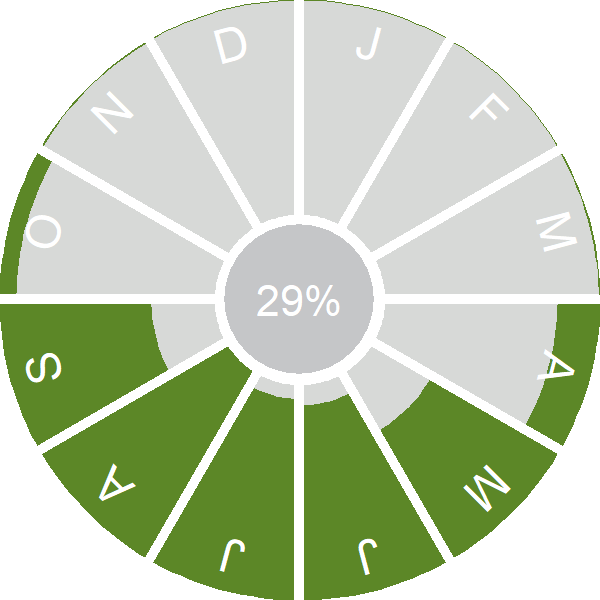House Martin
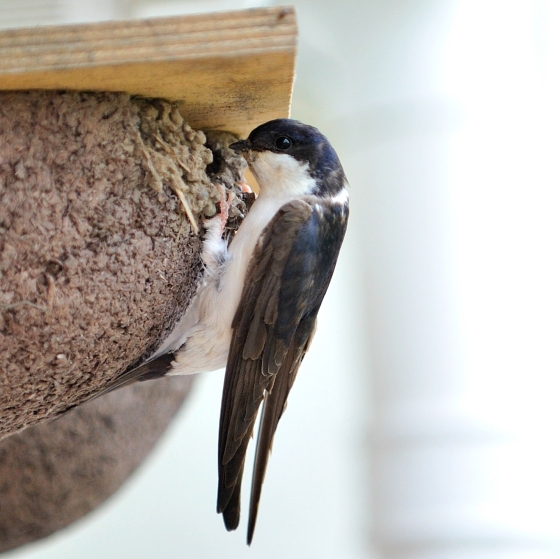
Introduction
This small hirundine is a familiar bird due to its habit of nesting in small colonies under the eaves of our homes.
Migrating to the UK & Ireland in early spring, House Martins construct nest cups from mud, and lay two broods on average in a single summer. Birds, which have a distinctive white rump, can be seen anywhere throughout Britain & Ireland in the summer months. Flocks may be seen overhead in early autumn as they gregariously catch insects to fuel their return migration. Although House Martins migrate to Africa, the exact non-breeding range of House Martins that breed in the UK & Ireland is still not known.
Declines in House Martin numbers led to this species being added to the UK Red List in 2020. These declines have been most severe in the south and east of Britain. The reasons underpinning this decline are not well understood, although birds that build nests on PVC as opposed to brick, concrete or wood have much lower breeding success, with nests more likely to collapse on the PVC substrate.
- Our Trends Explorer gives you the latest insight into how this species' population is changing.

Key Stats
Identification
ID Videos
This section features BTO training videos headlining this species, or featuring it as a potential confusion species.
Hirundines & Swift
GBW: Swift, Swallow and House Martin
Songs and Calls
Song:
Call:
Flight call:
Status and Trends
Conservation Status
Population Change
The House Martin's loosely colonial nesting habits and its strong association with human settlements mean that it is extraordinarily difficult to monitor. Anecdotal evidence of decline is often unreliable, because demise of a colony may be balanced by single nests or small groups becoming established elsewhere. For these reasons, study areas should be large, covered thoroughly, and ideally randomly selected. A first national survey designed on these principles was undertaken by BTO in 2015 (see here ).
The available long-term data suggest a rapid decline, although the confidence intervals are wide and the BBS's first decade or so showed an increase. However the BBS map of change in relative density between 1994-96 and 2007-09 indicates that there were strong decreases over that period across southern and midland England and in Northern Ireland and increases in northern Britain and parts of the southwest. More recent BBS data confirm that the declines over the period 1995-2018 have mainly occurred in England and that numbers have increased in Scotland and Northern Ireland over the same period. The species was moved from the green to the amber list in 2002, because of moderate decline in the CBC trend for 1974-99, and is listed as of European concern following declines elsewhere in Europe (BirdLife International 2004). A decline has occurred across Europe since 1980 (PECBMS: PECBMS 2020a>).
Distribution
Breeding House Martins are widespread in Britain and Ireland with the exception of the highest parts of the Scottish Highlands, Shetland, the Outer Hebrides and some exposed parts of the west coasts of Scotland and Ireland. Densities are highest in the eastern half of Ireland. Abundance is especially low in some urban areas, including London, Birmingham, Dublin and Belfast, despite the species' reliance on buildings for nesting.
Occupied 10-km squares in UK
or view it on Bird Atlas Mapstore.
or view it on Bird Atlas Mapstore.
European Distribution Map
Distribution Change
Change in occupied 10-km squares in the UK
or view it on Bird Atlas Mapstore.
or view it on Bird Atlas Mapstore.
Seasonality
House Martin is a summer visitor, arriving through April and May and present until September/October.
Weekly pattern of occurrence
The graph shows when the species is present in the UK, with taller bars indicating a higher likelihood of encountering the species in appropriate regions and habitats.

Habitats
Breeding season habitats
Relative frequency by habitat
The graph shows the habitats occupied in the breeding season, with the most utilised habitats shown at the top. Bars of similar size indicate the species is equally likely to be recorded in those habitats.
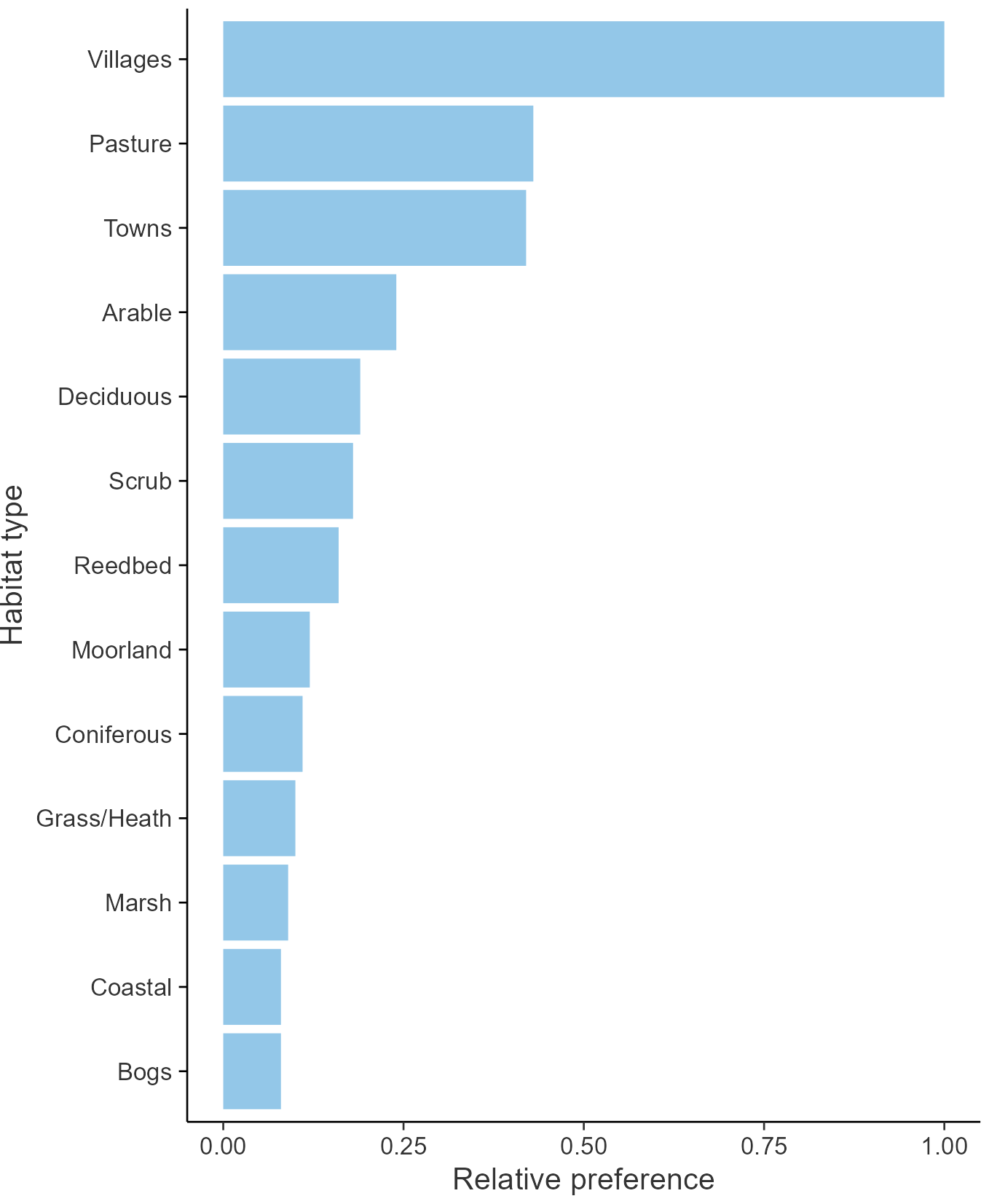
Movement
Britain & Ireland movement
Foreign locations of birds ringed or recovered in Britain & Ireland
Dots show the foreign destinations of birds ringed in Britain & Ireland, and the origins of birds ringed overseas that were subsequently recaptured, resighted or found dead in Britain & Ireland. Dot colours indicate the time of year that the species was present at the location.
- Winter (Nov-Feb)
- Spring (Mar-Apr)
- Summer (May-Jul)
- Autumn (Aug-Oct)

European movements
EuroBirdPortal uses birdwatcher's records, such as those logged in BirdTrack to map the flows of birds as they arrive and depart Europe. See maps for this species here.
The Eurasian-African Migration Atlas shows movements of individual birds ringed or recovered in Europe. See maps for this species here.
Biology
Productivity and Nesting
Nesting timing
Egg measurements
Clutch Size
Survival and Longevity
Survival is shown as the proportion of birds surviving from one year to the next and is derived from bird ringing data. It can also be used to estimate how long birds typically live.
View number ringed each year in the Online Ringing Report.
lifespan
Survival of adults
Survival of juveniles
Biometrics
Wing length and body weights are from live birds (source).
Wing length
Body weight
Ring Size
Classification, names and codes
Classification and Codes
- Order: Passeriformes
- Family: Hirundinidae
- Scientific name: Delichon urbicum
- Authority: Linnaeus, 1758
- BTO 2-letter code: HM
- BTO 5-letter code: HOUMA
- Euring code number: 10010
Alternate species names
- Catalan: oreneta cuablanca comuna
- Czech: jiricka obecná
- Danish: Bysvale
- Dutch: Huiszwaluw
- Estonian: räästapääsuke
- Finnish: räystäspääsky
- French: Hirondelle de fenêtre
- Gaelic: Gobhlan-taighe
- German: Mehlschwalbe
- Hungarian: molnárfecske
- Icelandic: Bæjasvala
- Irish: Gabhlán Binne
- Italian: Balestruccio
- Latvian: majas curkste
- Lithuanian: paprastoji langine kregžde
- Norwegian: Taksvale
- Polish: oknówka (zwyczajna)
- Portuguese: andorinha-dos-beirais
- Slovak: belorítka obycajná
- Slovenian: mestna lastovka
- Spanish: Avión común occidental
- Swedish: hussvala
- Welsh: Gwennol y Bondo
- English folkname(s): Window Swallow, Martlet
Research
Causes of Change and Solutions
Causes of change
The causes of the decline are currently unclear. A number of causes have been suggested but remain speculative and robust evidence to identify the main driver(s) of population change is lacking.
Further information on causes of change
Analysis of phenological data has found that the arrival date in the UK has advanced, between the 1960s and 2000s, by 16 days (Newson et al. 2016), although it is not currently known if and how this may affect breeding productivity for this species. Winter weather and food resources may be more limiting than conditions during the breeding season: annual survival rates from RAS sites in the UK for 1994-2004 were positively correlated with maximum monthly rainfall in West Africa. Some declines in survival rate are apparent over this period but they do not correspond well to the period of population decline (Robinson et al. 2008).
A number of breeding season factors have also been suggested as potential causes for the decline and for the contrasting trends between the north-west and south-east of the UK, but these are all speculative and robust evidence to identify one or more of these possible causes as a driver of population change is lacking. Previous research found that clutch sizes and the number of second broods varied by latitude and longitude (Moller 1984,Bryant 1975 ), and that breeding success is predominantly affected by foraging conditions (Bryant 1975, 1979,Poulin et al. 2010). Hence it is feasible that factors such as climate change and land use changes could have caused increases in breeding productivity in some parts of the UK and decreases elsewhere, causing the observed geographical variation in trends. However in the absence of demographic data it is not possible to confirm this. Competition with House Sparrow for nest sites has also been found to affect populations at local colonies (Tryjanowski & Kuczynski 1999). However, there is no evidence as yet to show that the overall proportion of usurped nests has changed over time and hence that House Sparrows could be having a population level effect.
Information about conservation actions
The main drivers of the decline for House Martin are not yet clear; hence, it is uncertain which conservation actions are most likely to directly benefit the species. However, it is known that House Martins usually prefer to use existing nests remaining from the previous year and will be more likely to raise two broods if they existing nests (e.g. Piersma 2013). Therefore, wherever possible, homeowners should leave existing nests in place over winter to enable them to be reoccupied the following spring.
Whilst research has not yet confirmed what factors are likely to be driving the decline and has therefore not tested possible solutions, there are some other actions which individuals and organisations can take as a precaution to address some of the potential factors whilst research is ongoing. Artificial nests will sometimes be used by House Martins and can therefore be provided alongside or to replace natural nests, particularly in cases where soffits and/or wall surfaces are replaced with PVC materials as anecdotal observation suggests such nests are more likely to collapse than those built on wood or brick surfaces. Another action which could be considered by site managers is the creation of 'House Martin towers' to provide potential nesting sites for House Martins on protected areas away from buildings. Such towers have been built for both House Martins and Swifts in several European countries.
Warmer, drier conditions as a result of climate change has also been suggested as a possible cause of the decline, and some homeowners have created muddy puddles during times of drought but the efficacy of this has not been tested.
Previous research suggests that breeding success may be predominantly affected by foraging conditions (Bryant 1975 , Bryant 1979; Poulin et al. 2010). Therefore, wider scale policies which aim to ensure habitat in the wider countryside supports invertebrates may also be important, e.g. reducing herbicide and pesticide use and creating natural habitat features.
Publications (5)
Birds of Conservation Concern Wales 4: the population status of birds in Wales
Author: Johnstone, I.G., Hughes, J., Balmer, D.E., Brenchley, A., Facey, R.J., Lindley, P.J., Noble, D.G. & Taylor, R.C.
Published: 2022
The latest review of the conservation status of birds in Wales. The report assessed all 220 bird species which regularly occur in Wales. There are now 60 species of bird on the Red List, with 91 on the Amber List and just 69 - less than a third of the total number of species - on the Green List.
06.12.22
Reports Birds of Conservation Concern

The status of our bird populations: the fifth Birds of Conservation Concern in the United Kingdom, Channel Islands and Isle of Man and second IUCN Red List assessment of extinction risk for Great Britain
Author: Stanbury, A.J., Eaton, M.A., Aebischer, N.J., Balmer, D., Brown, A.F., Douse, A., Lindley, P., McCulloch, N., Noble, D.G. & Win, I.
Published: 2021
Commonly referred to as the UK Red List for birds, this is the fifth review of the status of birds in the UK, Channel Islands and Isle of Man, published in December 2021 as Birds of Conservation Concern 5 (BOCC5). This updates the last assessment in 2015. Using standardised criteria, experts from a range of bird NGOs, including BTO, assessed 245 species with breeding, passage or wintering populations in the UK and assigned each to the Red, Amber or Green Lists of conservation concern.
01.12.21
Reports Birds of Conservation Concern
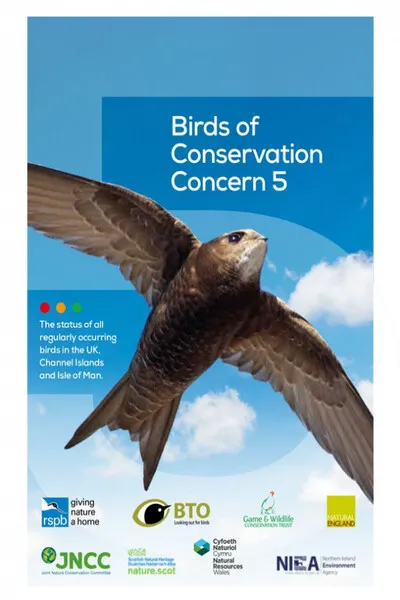
Using citizen science to assess drivers of Common House Martin breeding performance
Author: Kettel, E.F., Woodward, I.D., Balmer, D.E. & Noble, D.G.
Published: 2020
House Martin numbers in the UK have declined by 39% over a 25 year period, but it is unclear why. This small hirundine is a summer visitor that spends the winter months in an unknown part of sub-Saharan Africa, returning to build their cup-shaped nests under the eaves of buildings during April and May. In the 2016 and 2017 breeding seasons, BTO ran the House Martin Nest Study which involved members of the public monitoring the breeding behaviour of House Martins nesting close to where they lived.
02.10.20
Papers
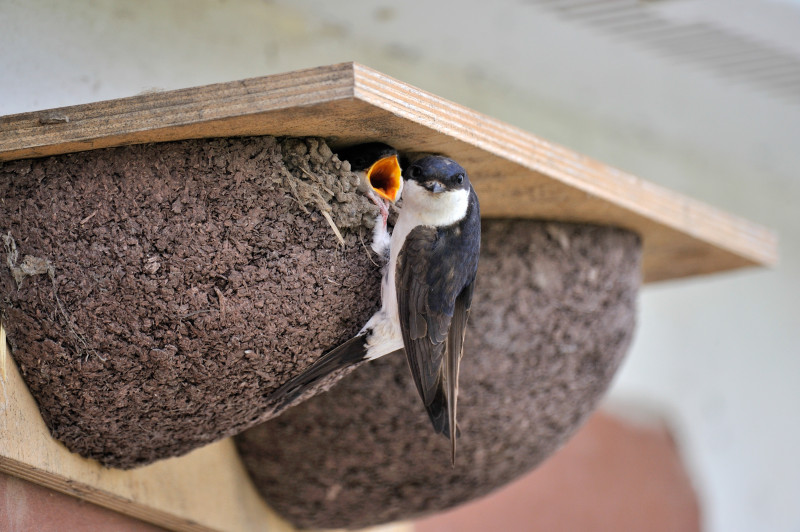
Identification of putative wintering areas and ecological determinants of population dynamics of Common House-Martin Delichon urbicum and Common Swift Apus apus breeding in Northern Italy
Author: Ambrosini, R., Orioli, V., Massimino, D. & Bani, L.
Published: 2011
To identify the causes of population decline in migratory birds, researchers must determine the relative influence of environmental changes on population dynamics while the birds are on breeding grounds, wintering grounds, and en route between the two. This is problematic when the wintering areas of specific populations are unknown. Here, we first identified the putative wintering areas of Common House-Martin (Delichon urbicum) and Common Swift (Apus apus) populations breeding in northern Italy as those areas, within the wintering ranges of these species, where the winter Normalized Difference Vegetation Index (NDVI), which may affect winter survival, best predicted annual variation in population indices observed in the breeding grounds in 1992–2009. In these analyses, we controlled for the potentially confounding effects of rainfall in the breeding grounds during the previous year, which may affect reproductive success; the North Atlantic Oscillation Index (NAO), which may account for climatic conditions faced by birds during migration; and the linear and squared term of year, which account for nonlinear population trends. The areas thus identified ranged from Guinea to Nigeria for the Common House-Martin, and were located in southern Ghana for the Common Swift. We then regressed annual population indices on mean NDVI values in the putative wintering areas and on the other variables, and used Bayesian model averaging (BMA) and hierarchical partitioning (HP) of variance to assess their relative contribution to population dynamics. We re-ran all the analyses using NDVI values at different spatial scales, and consistently found that our population of Common House-Martin was primarily affected by spring rainfall (43%–47.7% explained variance) and NDVI (24%–26.9%), while the Common Swift population was primarily affected by the NDVI (22.7%–34.8%). Although these results must be further validated, currently they are the only hypotheses about the wintering grounds of the Italian populations of these species, as no Common House-Martin and Common Swift ringed in Italy have been recovered in their wintering ranges.
01.01.11
Papers
Guests of Summer
Author: Theunis Piersma
Published: Summer 2016
Guests of Summer provides a fascinating insight into the lives of one of our most enigmatic and enchanting small birds - the House Martin.
22.03.16
Books and guides

